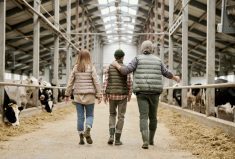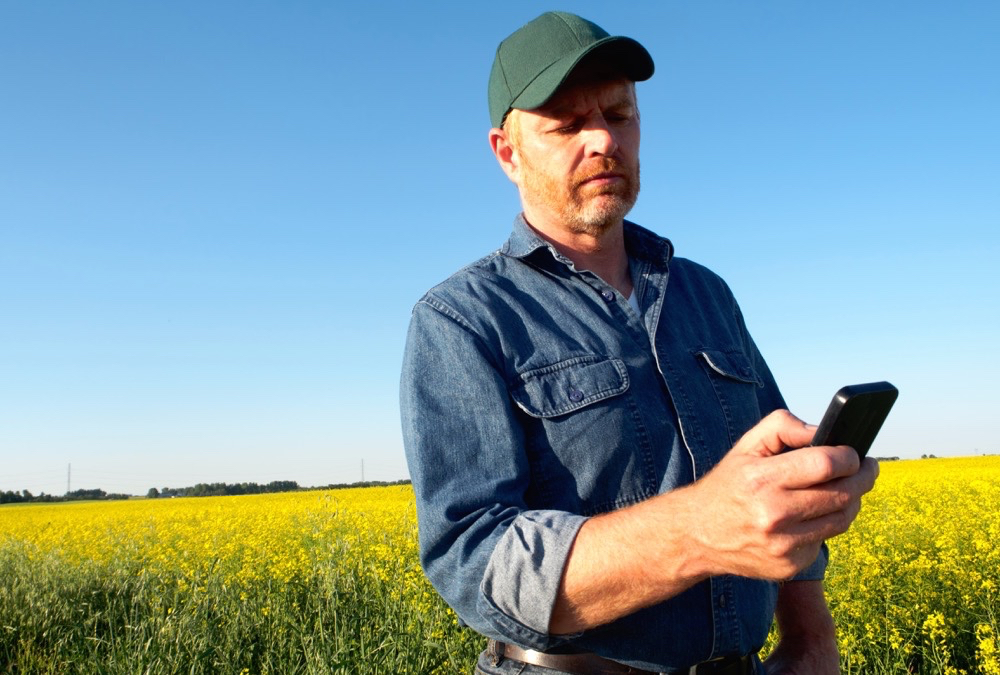The best time to figure out whether or not you can afford to borrow more money probably isn’t when you get a tip off that the neighbour wants to sell some land at a really tempting price. But inevitably, it’s when faced with those kinds of situations that producers take stock of where they are financially and seek advice from their bank or financial advisor about what the farm business can and can’t afford.
But as interest rates continue to edge upwards, it’s probably a good idea to have that conversation sooner than later, or at the very least look at some financial indicators that can give you an idea of what you can buy, when, for how much and with what.
Read Also

Cancer agency reclassifies another herbicide ‘probably carcinogenic’
The WHO’s cancer research agency has now put atrazine, a herbicide well known to corn growers, in the same potential-hazard category where the agency put glyphosate.
“There are some key financial ratios that are important to all business types,” says Farm Credit Canada’s chief agricultural economist, J.P. Gervais. “Current ratio is very important. Do you have enough cash to cover all of your short-term debt? Debt-to-asset is also a very common ratio that financial institutions use to evaluate financial risk. Knowing your ratio helps you to be better prepared when having conversations about future opportunities on the farm with your accountant or relationship manager.”
As any farmer studying his or her bank statements knows, interest rates have been slowly increasing over the past year, reflecting a stronger Canadian economy. Volatility of agricultural markets, triggered by global trade tensions and weather concerns is another factor to manage.
Total Canadian farm debt increased to over $102 billion in 2017, and with four interest hikes since last September, the cost of borrowing has gone up even more since then. But many agricultural economists believe Canadian agriculture is in good shape and well positioned to weather any future interest rate hikes. That sounds reassuring, but what does it mean at the farm level? How do farmers, with a wary eye on climbing interest rates, make sound borrowing decisions?
The decision of whether or not to borrow money will be influenced by a number of factors including current profitability, cash on hand and existing leverage to name a few, says Gervais. “Borrowing money is a tool for farms to achieve the goals of their operation,” he adds. “Debt is a tool that helps farmers execute their short- and long-term strategies, allowing farms to take advantage of opportunities in the marketplace when they become available.”
Whether it’s purchasing land, buying new equipment or purchasing farm inputs in the fall, what’s important is to have a business plan so you are equipped to evaluate market opportunities and act — using cash or debt. Gervais advises producers to work with trusted partners such as an accountant or farm adviser to determine the optimal debt structure for their operation.
Unfortunately, there is no specific ratio calculation to tell you whether or not you should borrow more money or concentrate on reducing debt. There are, however, calculations that the Canadian agricultural industry and financial institutions use that are also useful to producers to help determine the financial health of their farm.
Canadian agricultural economists use a number of different indicators — such as debt-to-asset ratio — to assess the financial health of the industry, but those same measures can’t always be applied in the same way to individual farms. A farm may have a low debt-to-asset ratio, which means it has more flexibility to borrow money to take advantage of a great opportunity, but does it always mean the farm can handle more debt, especially if interest rates continue to rise?
As debt increases, whether it’s through variable-rate loans or lines of credit, interest costs are inevitably higher. One way to assess a farm’s tolerance for interest rate increases is the Debt Service Coverage Ratio (DSCR), which is calculated by dividing net operating income (earnings before interest, depreciation and amortization) by the operation’s annual debt service payments. This tells the farmer how much cash is available to pay off debt.
For example, a farm has a net operating income of $75,000 and a loan amount of $500,000 amortized over a 10-year period. At a three per cent interest rate, the DSCR is 1.29. A two per cent increase in the interest rate lowers the DSCR to 1.18, indicating a greater drain on net income.
But, says FCC’s Amy Carduner, interest rates are not the only source of risk that farmers need to watch out for. A decline in farm incomes that reduces the revenue available to service debt will also have an effect on financial strength. For example, a 10 per cent decrease in net operating income together with a two per cent increase in the interest rate would decrease the DCSR to 1.06, indicating that the capacity to repay debt might be tight. If a farmer’s DSCR is lower than one it means he or she has insufficient funds to meet debt obligations. A DSCR over 1.25 means the producer has enough room to meet unexpected changes — like higher interest rates or reduced income.
“It is important producers know the financial health of their farm in terms of many ratios,” says Gervais. “It’s important to understand the cash, leverage and profitability of their operation. These ratios are, however, not meant to be used as benchmarks because they represent the industry’s financial position and thus include operations that carry no debt, and operations that are at various stage of development.”
Using ratios to assess financial health
Looking at some of the financial measures Statistics Canada uses to assess the health of Canadian agriculture — like ratios — can help farmers better understand and benchmark their own operations and make sound financial decisions, says Amy Carduner, an agricultural economist with Farm Credit Canada (FCC) in a recent blog post.
Below are some common ratios used as financial health indicators for the Canadian agricultural industry that are also applicable to individual farms.
Ratios can measure different aspects of a business such as liquidity, solvency, profitability, financial efficiency or debt servicing ability. This list concentrates on the indicators that help assess a business’ ability to pay its short-term and long-term obligations such as input costs, loans, labour expenses and taxes, as well as its ability to buy assets or take on more debt.
Liquidity and solvency ratios
Liquidity is the ability to meet long-term financial commitments. Solvency is the ability to pay short-term obligations.
Current Ratio:
Measures liquidity
= Current Assets / Current Liabilities
The current ratio is calculated by dividing current assets by current liabilities. Current assets are things such as cash, crops, grain inventories, livestock, inputs such as seed, feed or fertilizer and accounts receivable that can be converted into cash within 12 months. Current liabilities include accounts payable, credit card balances, operating lines of credit, accrued interest and the principal due of long-term loans over the next 12 months.
A current ratio assesses the business’ ability to cover current liabilities using current assets. The higher the ratio, the more flexibility and resilience a business has if adverse market conditions affect sales or the cost of borrowing increases.
As a rule of thumb, a current ratio of 2:1 (two dollars of assets to one dollar of current liabilities) to 1.5:1 is good. Ratios of 1:1 or less are weak and can cause cash flow problems.
Manitoba Agriculture’s FarmPlan: Analyzing a Farm Business document suggests the following tips.
Be aware of how saleable current assets are, when they will be sold and for what price. For example, silage or hay may not be saleable, grain sales may be subject to delivery restrictions, and fall-applied fertilized cannot be converted into cash. These factors may make a current ratio seem weaker than expected; interpreting the ratio may be as important as its numerical value.
Debt to Asset Ratio (DAR):
Measures solvency
The Debt to Asset Ratio divides total liabilities by total assets, to indicate the extent to which assets are funded by debt (and not equity). As an example, if a farm operation has a DAR of .15 it means that every $1 of assets is funded with $0.15 of debt.
Total assets and liabilities include things such as long-term debt, breeding livestock, buildings and equipment, farmland, improvements such as fencing or tile drainage, capital return and investments.
A lower DAR means a farm has more flexibility to withstand financial challenges. Generally, a farm business with less than 25 per cent of its assets financed with debt is in a strong position. If 25 to 40 per cent of assets are financed with debt the business is still moderately strong, but when 60 per cent or more assets are financed with debt, the business is at higher financial risk.
Farmers that fund asset purchases with more debt than equity risk having problems repaying debt. Because of the cyclical nature of commodity and input prices and the pressure that puts on cash flows, economists recommend farmers maintain a healthy year-round DAR, however hard it is to say no when a “great” deal comes around.
Another thing to consider when looking at DAR is that not all are created equal. The type of operation can influence the amount of debt it can safely carry.
Return on Assets (ROA):
Measures profitability
= (Net Farm Income + Interest – Unpaid Labour and Management Costs) / Farm Assets
Return on Assets Ratio is calculated by dividing net farm income plus interest expense, less unpaid labour and management costs, by the average value of the farm assets for the period. ROA measures profitability based on the rate of return that the farm business earns on its average asset base. In the formula, interest costs are added back to net income so returns before the costs of borrowing can be considered. The higher the ROA, the more profitable the business.
A typical ROA for many farms is two to five per cent. Although there is no “ideal” ROA, a farm with a lower ROA may find it more difficult to service additional debt.
Return on Equity (ROE):
Measures profitability
= (Net Farm Income – Unpaid Labour and Management Costs) / Net Worth
Return on Equity is calculated by dividing net farm income less unpaid labour and management costs, by the average value of the farm equity (net worth) for the period.
ROE measures the return to the net worth or equity in the farm business. Farm equity is capital that could be invested elsewhere if a producer was not farming, so it’s a way to figure out what kind of return the farm is making compared to other investments.
A return on equity higher than the return on assets can show that borrowing money was a sound business decision. The return on the borrowed capital was greater than the cost of borrowing.
ROE can fluctuate widely from year to year — especially if the farm has a lot of debt and little equity. Typical ROEs for farms are between four and eight per cent.
Ratios aren’t everything
Remember that a ratio is just one number divided by another; ratios don’t magically tell you what to do. It’s hard to judge if a ratio is good or bad as it relates to any individual farm because so many factors can affect the performance of a business. Consider individual circumstances when looking at ratios. They are simply tools to help you understand your business, either as a benchmark to measure performance against similar operations, or to monitor changes over time.
















